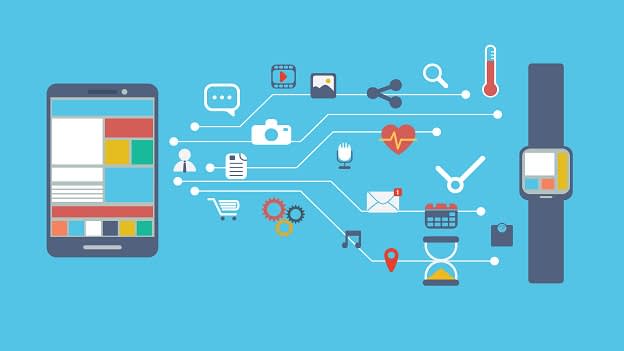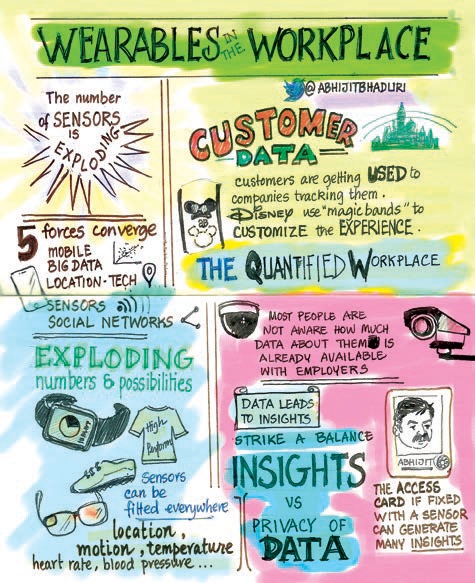Wearables at the workplace

By 2018, two million employees will be required to wear health and fitness tracking devices as a condition of employment
Research done on wearables led the Bank of America to discover that their most productive workers were those that routinely shared tips and frustrations with their colleagues
Sensors are showing up everywhere. Fix them to any surface and they start transmitting data about location, motion, temperature and more. The flow of data once triggered is relentless. The mobile phone you carry knows your location. That in itself can create a wealth of options. You can use maps to navigate. The apps can suggest the restaurants and other events nearby. The sensors in your smartphone provide data for the apps that can help you track everything from your heartbeat to your sleep patterns, your activity levels etc. Based on that information, there are providers who can send you targeted ads, suggest music and tell you where your friends are hanging out. Five major forces i.e.Mobile (including wearables), Big Data, location-based technologies, sensors and social networks will converge to drive far reaching changes even in the workplace.
Exploding numbers & possibilities
The total shipment of wearables in 2014 was 19.6m. This year that number has jumped to more than 45m and is expected to cross 125m in 2019. Wearables can be embedded in wristwear (e.g. the watch or fitness band), in the clothing or shoes (already used by most athletes to improve performance); in eyewear (think Google glass and contact lenses that can track glucose levels for diabetics).
The creation of epidermal electronics—wearable health and wellness sensors "printed" directly onto the skin is changing how we track our heart rates at the gym and blood pressure at the doctor's office.
Wearables for customers
Disney uses “magic bands” at their resorts. If you’re wearing your Disney Magic Band and you’ve made a reservation, a host will greet you at the drawbridge and already know your name. No matter where you sit, your server knows where you are and will bring your order to your table magically. They are already getting customers to use wearables to personalize the offerings and target ads and deals for products the customer will find irresistible. Companies are already getting customers used to the idea of wearables tracking them. This is a great example of using wearables to create an immersive experience for customers.Nordstrom wanted to learn more about its customers — how many came through the doors, how many were repeat visitors — the kind of information that e-commerce sites like Amazon have in spades. So in 2013,the company used technology that allowed it to track customers’ movements by following the Wi-Fi signals from their smartphones.
The location sensing technology could track who was a repeat customer, the paths they traced in the store, which items held their interest, and how long they paused and hesitated before purchasing something. This data is what enables them to customize everything from the mix of items on sale to the price points depending on the customers that walk into the store.
Salesforce lists the many possibilities that wearables can throw up for enhancing the customer experience, help design reward and loyalty programs, create a cashless payment system that can be designed on the wearable, or have an integrated shopping experience to name just a few possibilities.

Wearables as a condition of employment
Most employers already have a policy that allows employees to bring their own devices to work. The Human Resources team, the digital geeks and the legal department will soon have to sit down and plan how to handle a Bring Your Own Sensor policy. Can having a company provided wearable be made to be a condition of employment?
Yes. According to Gartner, by 2018, two million employees will be required to wear health and fitness tracking devices as a condition of employment. The health and fitness of people employed in jobs that can be dangerous or physically demanding will increasingly be tracked by employers via wearable devices. Tesco uses armbands to track goods transported to its aisles so that the worker does not have to mark it on clipboards. It also helps estimate completion time and can even provide data on fatigue. Boeing uses wearables to replace instruction manuals. The workers can get instructions in real time.
A headband with a sensor can provide useful data that can give insights about EEG patterns that can help us get insights on when we are feeling creative, productive or plain bored. The employer could then decide to offer you work that suits your moods. A fitness tracker can provide the employer real time data about activity levels and fitness levels of the employees and help them negotiate better rates on health and hospitalization insurance. Once the data exists then predictive models can warn the employer about surges and dips in costs due to stress levels and increasing activity.
Simply tracking the employees productivity levels can provide objective data to decide which employees are the most productive and should be given differentiated rewards.
The Quantified Workplace
More than half of human resources departments around the world report an increase in the use of data Analytics compared to its use three years ago, according to a recent survey by the Economist Intelligence Unit. But many employees are still blissfully unaware of how information they may deem private is being analyzed by their managers.
The easiest spot to embed a sensor is the employee badge. Already organizations routinely use it to provide access to different parts of the office. The employer can use the sensors to activate or deactivate access. The badges monitor how employees move around the workplace; who they talk to and in what tone of voice; how long they are spending; which bosses are spending time with the employees, and then correlate the data with productivity norms or employee engagement surveys to determine if that time spent is resulting in something productive or not.
Tracking any data can lead to insights. Bank of America and Deloitte map office behaviors to Sales, Revenue and Retention rates. Research done on wearables led the Bank of America to discover that their most productive workers were those that routinely shared tips and frustrations with their colleagues. That insight led them to replace individual break times with collective downtime that was scheduled in chunks of 15 minutes. The result was a 23 percent improvement in performance and a 19 percent drop in stress levels.
Insights vs privacy
Sociometric Badges made by Humanyze can measure movement, face-to-face speech, vocal intonation, who is talking to whom and for how long. We can understand what these patterns suggest about the flow of information and power.
Once we track data, the genie is out of the box. Knowing health data can help negotiate better insurance rates but can also open up possibilities of discrimination. Knowing workplace interaction patterns can help employers identify influencers in the workplace but also break up unions or troublemakers.
When data from the wearable is combined with social data, the outcome may be scary. The health tracker knows the location and your activity. When combined with social data, it can track who you are spending time with that you should not!!
What happens to the data when the employee leaves the employer? Who owns that data? Who is to guarantee how that data will be used? What rights does the employee have regarding their own data while they are in employment and when they are not? These are serious questions in the workplace where wearables may be generating data in real time without the employee knowing the possibilities and consequences of what they are agreeing to.
References
- http://www.complex.com/pop-culture/2013/03/thin-health-tracking-sensors-can-be-sprayed-onto-skin
- http://www.nytimes.com/2013/07/15/business/attention-shopper-stores-are-tracking-your-cell.html
- http://investor.salesforce.com/about-us/investor/investor-news/investor-news-details/2015/Wearables-in-the-Enterprise-are-Driving-Improved-Business-Performance/default.aspx
- http://solutions-review.com/mobile-device-management/by-2018-employees-will-be-required-to-wear-wearables/
- http://www.ft.com/intl/cms/s/2/d56004b0-9581-11e3-9fd6-00144feab7de.html#axzz3r9lHImvY












![E-book: HR Analytics and You [Download Now] E-book: HR Analytics and You [Download Now]](https://res.cloudinary.com/people-matters/image/upload/w_220,h_124,c_thumb,q_auto,f_auto/v1707908296/1707908294.jpg)
